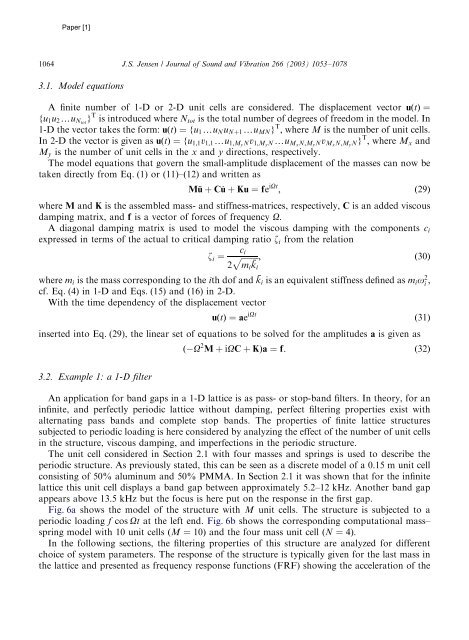WAVES AND VIBRATIONS IN INHOMOGENEOUS STRUCTURES ...
WAVES AND VIBRATIONS IN INHOMOGENEOUS STRUCTURES ...
WAVES AND VIBRATIONS IN INHOMOGENEOUS STRUCTURES ...
You also want an ePaper? Increase the reach of your titles
YUMPU automatically turns print PDFs into web optimized ePapers that Google loves.
1064<br />
3.1. Model equations<br />
A finite number of 1-D or 2-D unit cells are considered. The displacement vector uðtÞ ¼<br />
fu1u2yuNtot gT is introduced where Ntot is the total number of degrees of freedom in the model. In<br />
1-D the vector takes the form: uðtÞ ¼fu1yuNuNþ1yuMNg T ; where M is the number of unit cells.<br />
In 2-D the vector is given as uðtÞ ¼fu1;1v1;1yu1;MyNv1;MyNyuMxN;MyNvMxN;MyNg T ; where Mx and<br />
My is the number of unit cells in the x and y directions, respectively.<br />
The model equations that govern the small-amplitude displacement of the masses can now be<br />
taken directly from Eq. (1) or (11)–(12) and written as<br />
M.u þ C’u þ Ku ¼ fe iOt ; ð29Þ<br />
where M and K is the assembled mass- and stiffness-matrices, respectively, C is an added viscous<br />
damping matrix, and f is a vector of forces of frequency O:<br />
A diagonal damping matrix is used to model the viscous damping with the components ci<br />
expressed in terms of the actual to critical damping ratio z i from the relation<br />
ci<br />
zi ¼ ffiffiffiffiffiffiffiffiffi<br />
2 mi %ki<br />
p ; ð30Þ<br />
where mi is the mass corresponding to the ith dof and %ki is an equivalent stiffness defined as mio 2 i ;<br />
cf. Eq. (4) in 1-D and Eqs. (15) and (16) in 2-D.<br />
With the time dependency of the displacement vector<br />
uðtÞ ¼ae iOt<br />
inserted into Eq. (29), the linear set of equations to be solved for the amplitudes a is given as<br />
3.2. Example 1: a 1-D filter<br />
ARTICLE <strong>IN</strong> PRESS<br />
J.S. Jensen / Journal of Sound and Vibration 266 (2003) 1053–1078<br />
ð31Þ<br />
ð O 2 M þ iOC þ KÞa ¼ f: ð32Þ<br />
An application for band gaps in a 1-D lattice is as pass- or stop-band filters. In theory, for an<br />
infinite, and perfectly periodic lattice without damping, perfect filtering properties exist with<br />
alternating pass bands and complete stop bands. The properties of finite lattice structures<br />
subjected to periodic loading is here considered by analyzing the effect of the number of unit cells<br />
in the structure, viscous damping, and imperfections in the periodic structure.<br />
The unit cell considered in Section 2.1 with four masses and springs is used to describe the<br />
periodic structure. As previously stated, this can be seen as a discrete model of a 0:15 m unit cell<br />
consisting of 50% aluminum and 50% PMMA. In Section 2.1 it was shown that for the infinite<br />
lattice this unit cell displays a band gap between approximately 5.2–12 kHz: Another band gap<br />
appears above 13:5 kHz but the focus is here put on the response in the first gap.<br />
Fig. 6a shows the model of the structure with M unit cells. The structure is subjected to a<br />
periodic loading f cos Ot at the left end. Fig. 6b shows the corresponding computational mass–<br />
spring model with 10 unit cells ðM ¼ 10Þ and the four mass unit cell ðN ¼ 4Þ:<br />
In the following sections, the filtering properties of this structure are analyzed for different<br />
choice of system parameters. The response of the structure is typically given for the last mass in<br />
the lattice and presented as frequency response functions (FRF) showing the acceleration of the

















